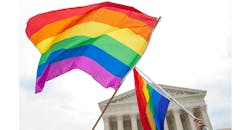Supreme Court Bans Discrimination Against LGBT Employees
The U.S. Supreme Court has taken a major step towards ending or at the very least curtailing incidents of workplace bullying, particularly when it’s aimed at LGBT workers. In a 6-3 decision, the Supreme Court has ruled that Title VII of the Civil Rights Act of 1964, which bans discrimination in the workplace on the basis of race, color, religion, sex, or national origin, applies as well to discrimination against LGBT employees.
Writing for the majority opinion, Justice Neil Gorsuch stated, “We must decide whether an employer can fire someone simply for being homosexual or transgender. The answer is clear. An employer who fires an individual for being homosexual or transgender fires that person for traits or actions it would not have questioned in members of a different sex. Sex plays a necessary and undisguisable role in the decision, exactly what Title VII forbids.”
As NPR’s Nina Totenberg points out, “Nearly half the states have no legal protection for LGBT employees. Now, the federal law will protect employees in those states from firing and other adverse employment decisions made on the basis of their sexual orientation or gender identity.”
Sandra L. Shullman, president of the American Psychological Association, praised the decision, stating, “When laws are enacted to prohibit discrimination against gay and transgender individuals, research has shown that health outcomes, both mental and physical, improve. Workplaces that have adopted LGBT-supportive policies have also benefited from improved health among those employees, as well as greater job commitment, job satisfaction and productivity.”
The implications of this Supreme Court’s ruling “cannot be understated,” emphasizes Sam Schwartz-Fenwick, partner with law firm Seyfarth and head of its LGBT Affinity Group. “Until [this ruling], most jurisdictions in the U.S. offered no employment protections to LGBT individuals. With this ruling, however, the anti-discrimination mandate of Title VII now protects LGBT individuals throughout the country. Employers, both those who already had LGBT inclusive policies and those who will now have to adopt them in order to comply with the law, will benefit from the growth in productivity and performance that comes when employees are allowed and encouraged to be themselves at work.”
“This decision is significant in that it will now create a consistent rule of law nation-wide with regard to the prohibition of discrimination against LGBT employees in the workplace,” says David Barron, labor & employment attorney at Cozen O’Conner. “That said, it is important to note that most states, and many localities, already had such anti-discrimination laws on the books before this decision. Similarly, the Equal Employment Opportunity Commission, the agency handling federal discrimination claims, has long taken the position that such claims are actionable under Title VII, and most large companies prohibit such discrimination in their policies. As a practical matter, these protections already existed in most workplaces across America.”
As Barron sees it, the decision takes a very expansive view of discrimination based on sex, one that casts asides terminology and labels. “Employers will need to ensure their training makes clear that stereotyping, harassment, or discrimination based on any aspect of sex or gender (not just orientation or sexual preference) is unlawful.”
This opinion will have a long term impact on employers subject to Title VII, i.e., those with 15 or more employees, observes Elaine Turner, a shareholder/partner at national law firm Hall Estill. “Regardless of contrary state laws, such employers may not discriminate against individuals in employment decisions because they are gay or transgender. Those that do, violate Title VII and are subject to legal actions against them that could be very costly.”
Turner anticipates there will be cases for the next several years addressing religious liberty issues that will be raised by some employers in defense of such Title VII claims. “Employers with less than 15 employees will continue to be governed by applicable state and local anti-discrimination laws,” she notes.
Tips for Hiring and Managing LGBT Workers
“The Supreme Court ruling is being celebrated as an important step in creating a more supportive and safer workplace for millions of LGBT Americans,” says Rob Wilson, employment expert and president of Employco USA, an employment solutions firm with locations across the country.
To adequately adhere to the new Supreme Court ruling, employers will need to become better educated and prepared when it comes to handling LGBT+ issues, both as it relates to hiring and harassment and beyond.
Wilson offers the following suggestions that employers should keep in mind when hiring and managing LGBT workers:
● The legal documents might not match the preferred name/pronoun of the applicant or employee. “On official legal forms, you must use the name and gender on the identification the employee gives you, regardless of how they present themselves in person. However, just because you must do so on the legal forms, it does not mean you must do so on the company website or the person's business cards, etc. Instead, use their preferred name.”
● Engage in an interactive process. “When it comes to issues of privacy, engage with the employee. Ask what pronoun they prefer. Ask if they want the other staff to know any details about their gender identity. Then, respect their choice.”
● Allow them to use the bathroom of their choice. “OSHA recommends that employers permit employees to use the bathroom of their choice, meaning that a transgender female should be permitted to use the female bathroom, or a transgender male should be permitted to use the male bathroom.”
● Head problems off before they happen. “Have an office-wide meeting with any managing personnel to let them know about how these issues will be handled. Update your handbooks to reflect that discrimination against transgender employees will not be tolerated. And, update your office dress code policy so that it is not gender-specific. In other words, instead of saying, 'Men must wear slacks' or ‘Women must wear skirts,’ say ‘Business casual’ or ‘No ripped clothing, logos, etc. allowed.’”
● Be tactful. “Many transgender people say they hate when people say, ‘Wow! I couldn’t tell you weren’t born a woman!’ or ‘I really thought you were a man!’ You might be trying to compliment them, but it comes off as demeaning or even bigoted,” says Wilson. “None of these comments belong in the workplace.”
● Don’t ask overly personal questions. “Inquiring about a person’s health is always a no-no in the office,” says Wilson, “and this shouldn’t change just because a person is transgender. Don’t ask about their hormones or if they plan to transition. It is both ethically and legally out-of-bounds.”
About the Author

Dave Blanchard
Editor-in-Chief / Senior Director of Content
During his career Dave Blanchard has led the editorial management of many of Endeavor Business Media's best-known brands, including IndustryWeek, EHS Today, Material Handling & Logistics, Logistics Today, Supply Chain Technology News, and Business Finance. In addition, he serves as senior content director of the annual Safety Leadership Conference. With over 30 years of B2B media experience, Dave literally wrote the book on supply chain management, Supply Chain Management Best Practices (John Wiley & Sons, 2021), which has been translated into several languages and is currently in its third edition. Prior to joining Endeavor/Informa/Penton, he spent a decade covering the artificial intelligence industry. He is a frequent speaker and moderator at major trade shows and conferences, and has won numerous awards for writing and editing. He is a voting member of the jury of the Logistics Hall of Fame, and is a graduate of Northern Illinois University.
